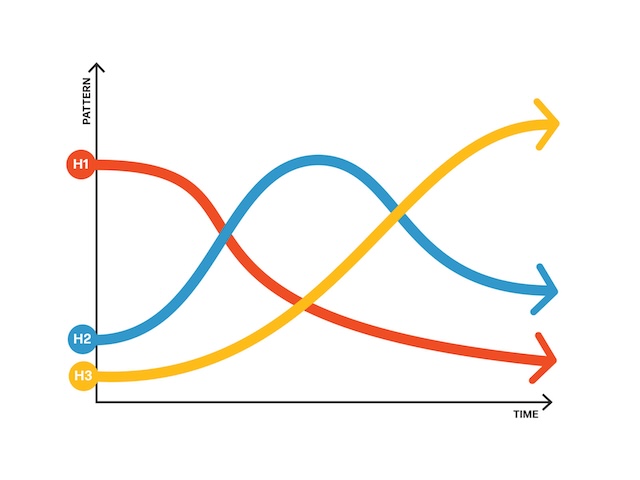The Three Horizons model is one of our key tools in the Regenerative Design Lab for exploring change. It’s simple enough to grab in a short space of time (see yesterday’s post on a the fit of a good tool), but deep enough to shape a deep, long-term exploration. For example we use the Three Horizons to create the arc of the Lab — in which we start with dreaming about a thriving future, return to the realities of the present, and then going on explore the steps that can create a change from one to the other.
The model also supports a half-day deep dive into innovation (See Kate Raworth’s excellent 6-minute video on facilitation questions to support such a process.)
But sometime the greatest value I see is in simply getting people familiar with the picture. If people can see the three mindsets — the manager (H1), the dreamer (H3) and the entrepreneur (H2) — the conversation can open up by itself.
Below is a 90-minute introduction I’ve been using. It gives people just enough structure to try on the model, and then lets them get on with using it. This is how it goes.
Three Horizons: 90-minute facilitation plan
Getting started
00h00 — Arrivals (10mins)
For the usual how-do-you-dos, and-I’m-sorry-I’m-lates.
00h10 – Warm-up (5mins)
Ask people to write down on post-it notes as many cool sustainability (or whatever topic you are interested in) initiatives as they have heard of on separate post-it notes. Requirements:
- It must exist in the real world or as a prototype
- Or it must have a website.
You don’t need to say this but we’ll use these later to populate Horizon Two.
00h15 — Introduce the model (10mins)
Acknowledge the familiar dynamic:
- Dreams of the future
- Frustrations with the present
- Lots of opportunities pop up, but it’s hard to know where to start.
Introduce the Three Horizons as a way to see all of three simultaneously.
Step 1 — Horizon Three: the future we want
00h25 Breakout (10mins)
Prompt questions:
- What are your hopes, dreams and values?
- What future would be proud to hand on to future generations?
- What elements of that future already exist?
Get participants to stick their post-it notes to the top right of the diagram.
00h35 Plenary (10mins)
Explore the different responses about the future.
- What was easy and hard to discuss?
- How did it feel to talk about the future?
Step 2 — Horizon One: Our reality
00h45 Breakout (10mins)
Prompt questions:
- What holds your attention?
- What keeps the current system in place?
- What is causing pressure for change?
Get participants to stick their post-it notes on the left of the diagram.
00h55 Plenary (10mins)
Explore the different responses about the present.
- What was easy and hard to discuss?
- How did it feel to talk about the present?
This is the part of the process that my colleague Will Arnold would refer to as the Pit of Despair — when hope goes out of the room. It important to acknowledge this, and to welcome in Horizon Two as a way forward.
Step 3 – Horizon Two: The ideas that move us forward
01h05 — Breakout (10mins)
Prompt questions:
- What steps could move us from H1 to H3?
- Which of these opportunities already exist (you can use entries from the warm-up exercise as a prompt)
01h15 — Plenary (10mins)
Explore:
- Which ideas act as stepping stones?
- What conditions will enable these seeds to grow?
- Who else needs to be involved?
Closing
01h25 – Conclusions (5mins)
- What does the overall picture reveal?
- How could use the model in your own work?
As a final signpost, I refer people to the Three Horizons entry in the Pattern Book for Regenerative Design and in our free online Tools for Regenerative Design.
01h30. Close.
Why this format works
This short workshop format gives participants:
- A felt experience of each of the mindsets
- A shared map of their collective thinking and their shared reality
- Provides just enough detail to get people familiar with the model so they can use it in more depth themselves.
Overall I think it shows what the Three Horizons does best: to help people hold the future, the present and the opportunity for change all at the same time.

